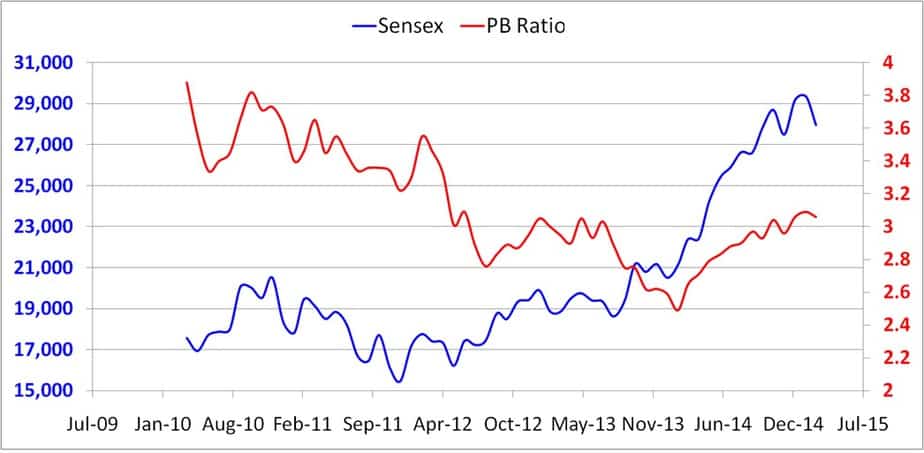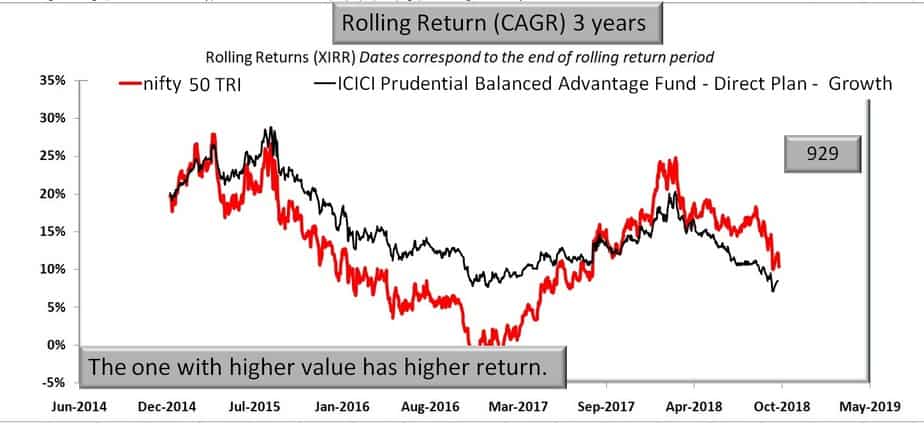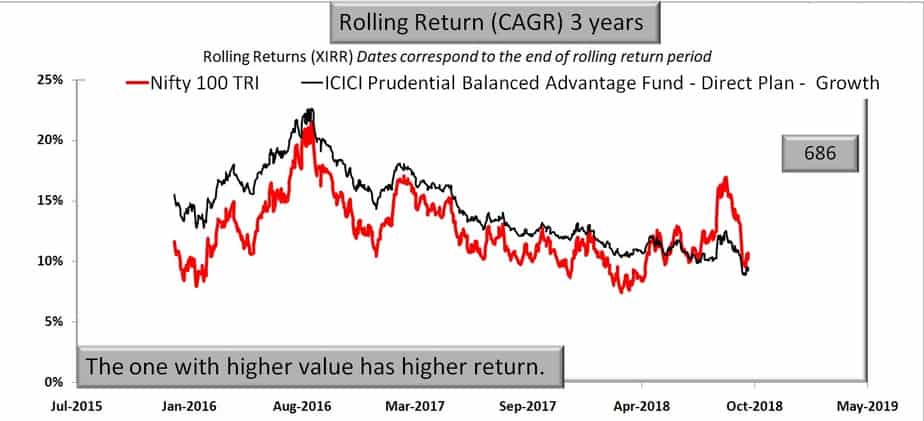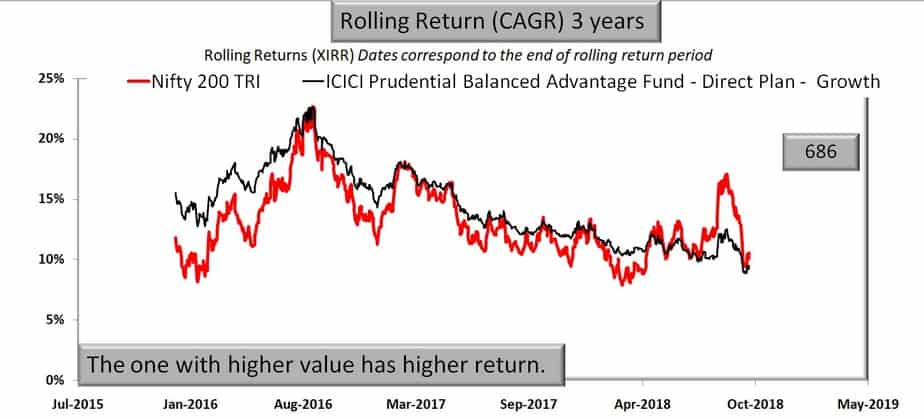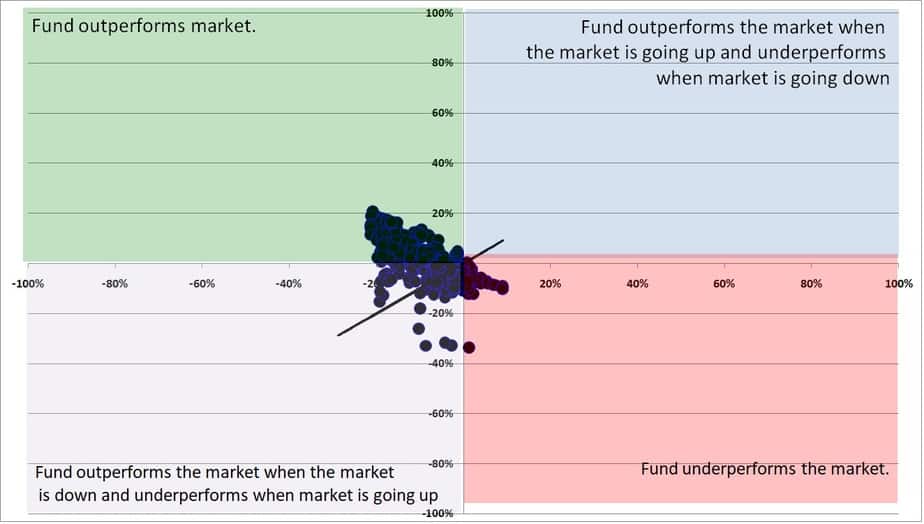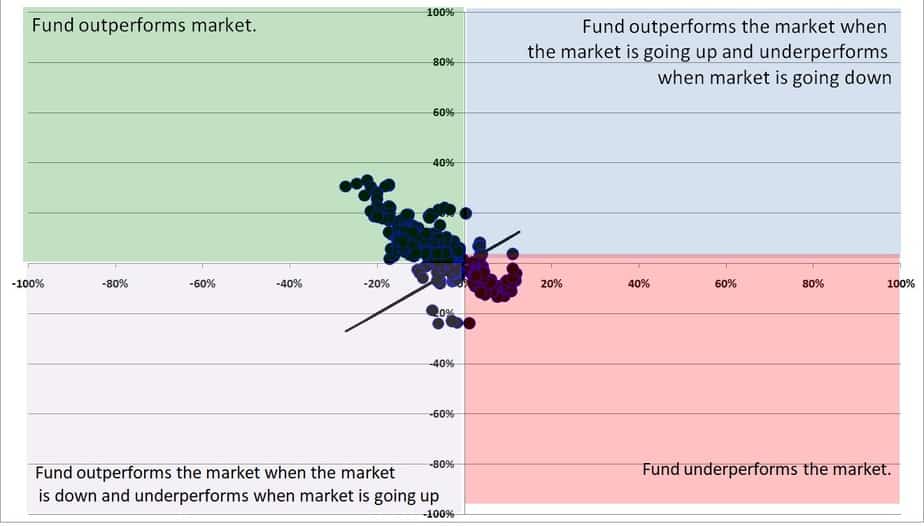Last Updated on December 29, 2021 at 11:56 am
This is a performance review (with video) of ICICI Prudential Balanced Advantage Fund ( I Pru Bal Adv) against broad market benchmarks like Nifty, Nifty 100 and 200 and composite benchmarks. I Pru Bal Adv is one of the finest dynamic asset allocation funds and here is why. I thank Ravikiran Suryanarayana for this post idea.
Missed the last few posts over the weekend? Catch up now:
- Are we now in a bear market? Market Analysis (October 2018)
- Why Aggressive Hybrid (balanced) Mutual Funds score over diversified funds
- List of funds that have consistently beat benchmarks with good downside protection
ICICI Prudential Balanced Advantage Fund, launched in Dec 2006 has been following a “buy low, sell high” tactical asset allocation model since 2010 (source: see AMC presentation linked below). This model is based on the price to book value (PB) of the index. Book value is essential the net worth of the stocks in the index (Nifty/Sensex)
ICICI Prudential Balanced Advantage Fund: Investment strategy
The fund can invest across large and midcaps. When the PB ratio is high, it indicates an overvalued market. The fund can reduce equity exposure by as much as 30% under such circumstances. When the PB ratio is low, it indicates an undervalued market and the equity exposure in the fund can increase up to 80%
Join 32,000+ readers and get free money management solutions delivered to your inbox! Subscribe to get posts via email! (Link takes you to our email sign-up form)
🔥Want to create a complete financial plan? Learn goal-based investing? Exclusive access to our DIY tools? Increase your income with your skills? Enjoy massive discounts on our robo-advisory tool & courses! 🔥
When the PB ratio is neither high nor low, it has medium equity exposure. It is called “balanced advantage” because of two reasons: (1) It can move from an equity-like fund to a balanced-like fund to a conservative hybrid fund depending on market conditions. (2) When it does this, it utilises arbitrage opportunities (which carry bond-like risk but are treated as equity for taxation) to ensure the overall equity exposure each month is over the required limit of 65%.
Thus it is able to offer significantly lower risk at favourable, equity fund-like taxation. Prior to April 30th 2018, the fund was benchmarked to CRISIL Aggressive Index (65% Nifty 50 and rest bonds) and was changed to CRISIL Hybrid Index (50% Nifty 50 + bonds). Source: fund factsheet
This slide from the fund house provides an overview of the strategy.
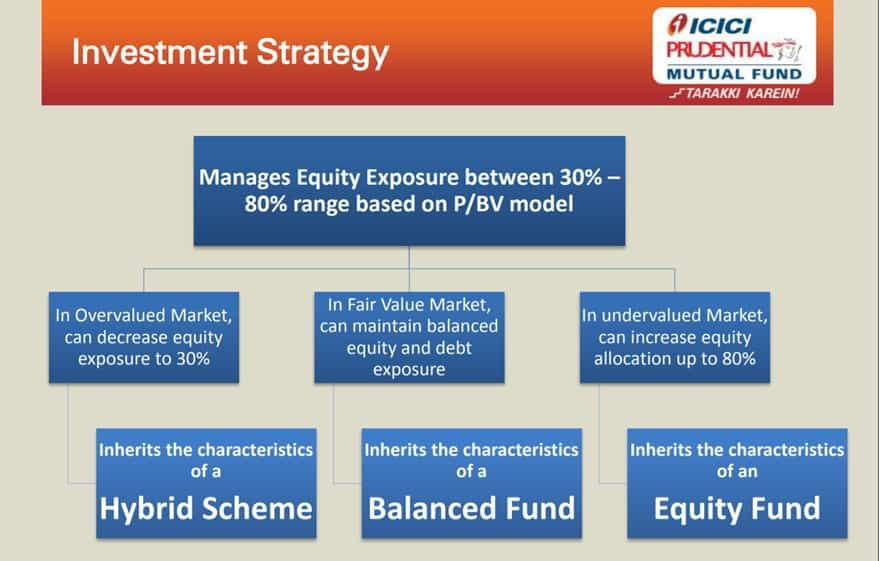 Another slide shows how the ICICI Prudential Balanced Advantage Fund’s direct equity exposure varies.
Another slide shows how the ICICI Prudential Balanced Advantage Fund’s direct equity exposure varies.
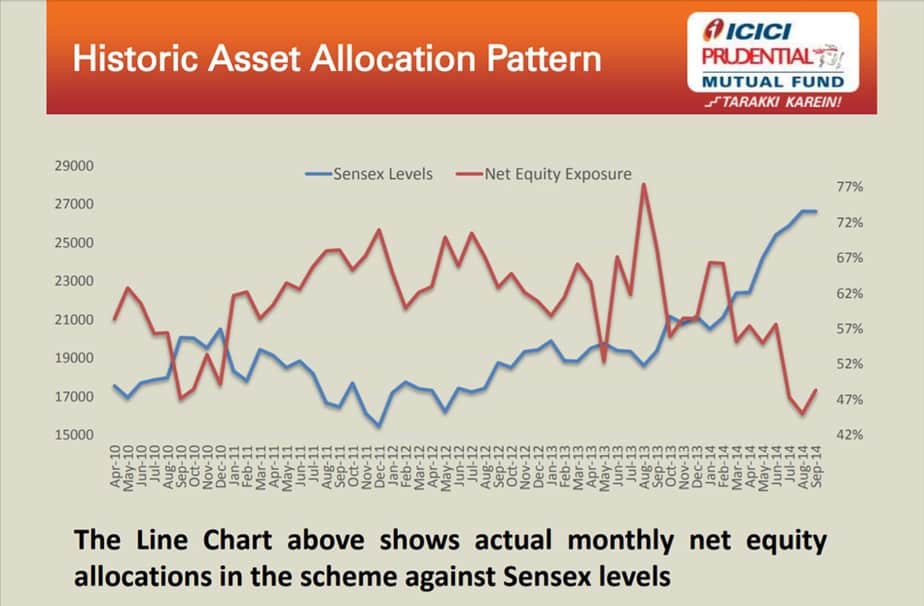 Now if you compare this with the Sensex PB during the same period, you will see an approximate resemblance. I guess the investor should expect 20-30% swings in direct equity exposure!
Now if you compare this with the Sensex PB during the same period, you will see an approximate resemblance. I guess the investor should expect 20-30% swings in direct equity exposure!
Review Video
This is the video version of this review. The freefincal youtube channel has several videos on the different aspect of money management. Do check them out and subscribe.
ICICI Prudential Balanced Advantage Fund vs Nifty 50
Although this is a dynamic asset allocation fund, I think it must be tested against broad market equity indices. So I have taken the direct plan and compared 3Y rolling returns with Nifty 50.
There are 929 3-year data points in each curve. That is a very good performance especially when you look at the rolling risk.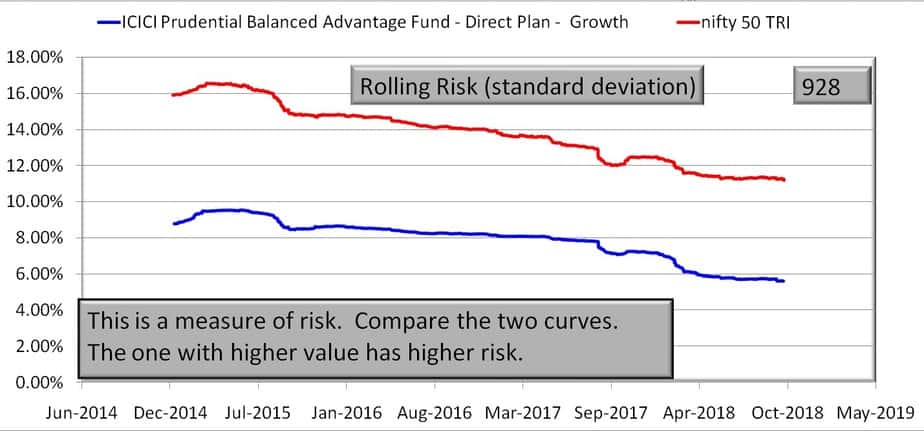
That is about 70-80% lower risk than the Nifty 50 with returns that match! It is a performer with low volatility.
ICICI Prudential Balanced Advantage Fund vs Nifty 100
Since it can invest across large caps and midcaps, the Nifty 100 and Nifty 200 comparison is worth a look. Again that is good going. Please take some time to study these graphs. I do not want to offer commentary on aspects that you can see for yourself.
ICICI Prudential Balanced Advantage Fund vs Nifty 200
You can plot such graphs for your funds with the freefincal rolling returns calculator.
Some stats with Nifty 200 TRI
5 years: Fund beat index 86 of 197 times with 100% downside protection. To understand what downside protection is read: What is mutual fund downside protection and why is it important? Essentially it means that the fund always fell less than this index.
4 years: Fund beat index 204/441 times with 100% downside protection.
3 years: Fund beat index 556/686 times with 100% downside protection.
Considering the 70-80% lower risk, this is excellent risk-adjusted performance.
ICICI Prudential Balanced Advantage Fund vs BSE Balanced
Since this is a dynamic balanced fund, a comparison with hybrid indices is appropriate. Unfortunately, hybrid index data is not available for free and so I make my own. BSE Balanced = 70% BSE Allcap + 30% BSE India Bond Index. You can read more about it here: A new and accessible benchmark for balanced mutual funds
For comparison, I have used Fingerprinting: A Visual Tool for Analyzing Mutual Fund Performance. This takes month returns of the fund, compares it with the index and plots them into sections.
Notice that most of the monthly returns fall in “good regions”. You get outperformance with downside protection.
ICICI Prudential Balanced Advantage Fund vs BSE Hyrbid
BSE Hybrid = 50% BSE Allcap + 50% BSE India Bond Index. This is more in line with its present benchmark. Again that is fairly decent performance.
Impression
I Pru Bal Adv is an excellent choice for investors who prefer low volatility and reasonable returns. Although the fund may not always beat broad market equity indices, it should do well given enough time.
Please note that although the volatility is lower, in the event of huge market crashes, this fund will suffer too. So be prepared for that.
My only con with regard to this fund, well with regard to the marketing of this fund is that its dividend option was pushed as “monthly income” option to many especially retirees and this contributes significantly to its AUM. I do hope after April 2018 when all equity dividends will be taxed at sources, investors (esp those holding regular plan units) had the sense to switch to the growth option in the direct plan. Since the NAV is currently down, it is still not too late to switch tax-free. See: Use this “market crash” to clean up your equity fund portfolio tax free!
During turbulent markets, such hybrid funds are pushed more and this can suddenly increase the AUM of the fund if there is a big crash. Large AUM is not a problem per se but a large change in the AUM can be troublesome for the fund manager. Already the AUM is pretty healthy at 28,616 crores! Well, the reason is obvious: the expense ratio of the regular plan is 2.12% and that of the direct plan is 0.99%. Products with high commissions are “always good for the customer”
So the choice is clear: choose the direct plan of any fund, especially this one, but be wary of spikes in AUM. Other than that, this is a fantastic fund. If you are worried about this, ICICI Prudential Dynamic Equity Fund, now ICICI prudential Multi-asset fund can be a good alternative (it used to follow the same PB strategy). This fund will have to hold equity + bonds + gold at all times and the equity exposure can drop below 65%, but since it does have about 10,000+ crores, we can expect the fund manager to keep it “equity-like”.
Missed the last few posts over the weekend? Catch up now:
- Are we now in a bear market? Market Analysis (October 2018)
- Why Aggressive Hybrid (balanced) Mutual Funds score over diversified funds
- List of funds that have consistently beat benchmarks with good downside protection
🔥Enjoy massive discounts on our courses, robo-advisory tool and exclusive investor circle! 🔥& join our community of 7000+ users!
Use our Robo-advisory Tool for a start-to-finish financial plan! ⇐ More than 2,500 investors and advisors use this!
Track your mutual funds and stock investments with this Google Sheet!
We also publish monthly equity mutual funds, debt and hybrid mutual funds, index funds and ETF screeners and momentum, low-volatility stock screeners.





- Do you have a comment about the above article? Reach out to us on Twitter: @freefincal or @pattufreefincal
- Have a question? Subscribe to our newsletter using the form below.
- Hit 'reply' to any email from us! We do not offer personalized investment advice. We can write a detailed article without mentioning your name if you have a generic question.
Join 32,000+ readers and get free money management solutions delivered to your inbox! Subscribe to get posts via email! (Link takes you to our email sign-up form)
About The Author
 Dr M. Pattabiraman(PhD) is the founder, managing editor and primary author of freefincal. He is an associate professor at the Indian Institute of Technology, Madras. He has over ten years of experience publishing news analysis, research and financial product development. Connect with him via Twitter(X), Linkedin, or YouTube. Pattabiraman has co-authored three print books: (1) You can be rich too with goal-based investing (CNBC TV18) for DIY investors. (2) Gamechanger for young earners. (3) Chinchu Gets a Superpower! for kids. He has also written seven other free e-books on various money management topics. He is a patron and co-founder of “Fee-only India,” an organisation promoting unbiased, commission-free investment advice.
Dr M. Pattabiraman(PhD) is the founder, managing editor and primary author of freefincal. He is an associate professor at the Indian Institute of Technology, Madras. He has over ten years of experience publishing news analysis, research and financial product development. Connect with him via Twitter(X), Linkedin, or YouTube. Pattabiraman has co-authored three print books: (1) You can be rich too with goal-based investing (CNBC TV18) for DIY investors. (2) Gamechanger for young earners. (3) Chinchu Gets a Superpower! for kids. He has also written seven other free e-books on various money management topics. He is a patron and co-founder of “Fee-only India,” an organisation promoting unbiased, commission-free investment advice.Our flagship course! Learn to manage your portfolio like a pro to achieve your goals regardless of market conditions! ⇐ More than 3,000 investors and advisors are part of our exclusive community! Get clarity on how to plan for your goals and achieve the necessary corpus no matter the market condition is!! Watch the first lecture for free! One-time payment! No recurring fees! Life-long access to videos! Reduce fear, uncertainty and doubt while investing! Learn how to plan for your goals before and after retirement with confidence.
Our new course! Increase your income by getting people to pay for your skills! ⇐ More than 700 salaried employees, entrepreneurs and financial advisors are part of our exclusive community! Learn how to get people to pay for your skills! Whether you are a professional or small business owner who wants more clients via online visibility or a salaried person wanting a side income or passive income, we will show you how to achieve this by showcasing your skills and building a community that trusts and pays you! (watch 1st lecture for free). One-time payment! No recurring fees! Life-long access to videos!
Our new book for kids: “Chinchu Gets a Superpower!” is now available!


Must-read book even for adults! This is something that every parent should teach their kids right from their young age. The importance of money management and decision making based on their wants and needs. Very nicely written in simple terms. - Arun.Buy the book: Chinchu gets a superpower for your child!
How to profit from content writing: Our new ebook is for those interested in getting side income via content writing. It is available at a 50% discount for Rs. 500 only!
Do you want to check if the market is overvalued or undervalued? Use our market valuation tool (it will work with any index!), or get the Tactical Buy/Sell timing tool!
We publish monthly mutual fund screeners and momentum, low-volatility stock screeners.
About freefincal & its content policy. Freefincal is a News Media Organization dedicated to providing original analysis, reports, reviews and insights on mutual funds, stocks, investing, retirement and personal finance developments. We do so without conflict of interest and bias. Follow us on Google News. Freefincal serves more than three million readers a year (5 million page views) with articles based only on factual information and detailed analysis by its authors. All statements made will be verified with credible and knowledgeable sources before publication. Freefincal does not publish paid articles, promotions, PR, satire or opinions without data. All opinions will be inferences backed by verifiable, reproducible evidence/data. Contact information: To get in touch, use this contact form. (Sponsored posts or paid collaborations will not be entertained.)
Connect with us on social media
- Twitter @freefincal
- Subscribe to our YouTube Videos
- Posts feed via Feedburner.
Our publications
You Can Be Rich Too with Goal-Based Investing
 Published by CNBC TV18, this book is meant to help you ask the right questions and seek the correct answers, and since it comes with nine online calculators, you can also create custom solutions for your lifestyle! Get it now.
Published by CNBC TV18, this book is meant to help you ask the right questions and seek the correct answers, and since it comes with nine online calculators, you can also create custom solutions for your lifestyle! Get it now.Gamechanger: Forget Startups, Join Corporate & Still Live the Rich Life You Want
 This book is meant for young earners to get their basics right from day one! It will also help you travel to exotic places at a low cost! Get it or gift it to a young earner.
This book is meant for young earners to get their basics right from day one! It will also help you travel to exotic places at a low cost! Get it or gift it to a young earner.Your Ultimate Guide to Travel
 This is an in-depth dive into vacation planning, finding cheap flights, budget accommodation, what to do when travelling, and how travelling slowly is better financially and psychologically, with links to the web pages and hand-holding at every step. Get the pdf for Rs 300 (instant download)
This is an in-depth dive into vacation planning, finding cheap flights, budget accommodation, what to do when travelling, and how travelling slowly is better financially and psychologically, with links to the web pages and hand-holding at every step. Get the pdf for Rs 300 (instant download)